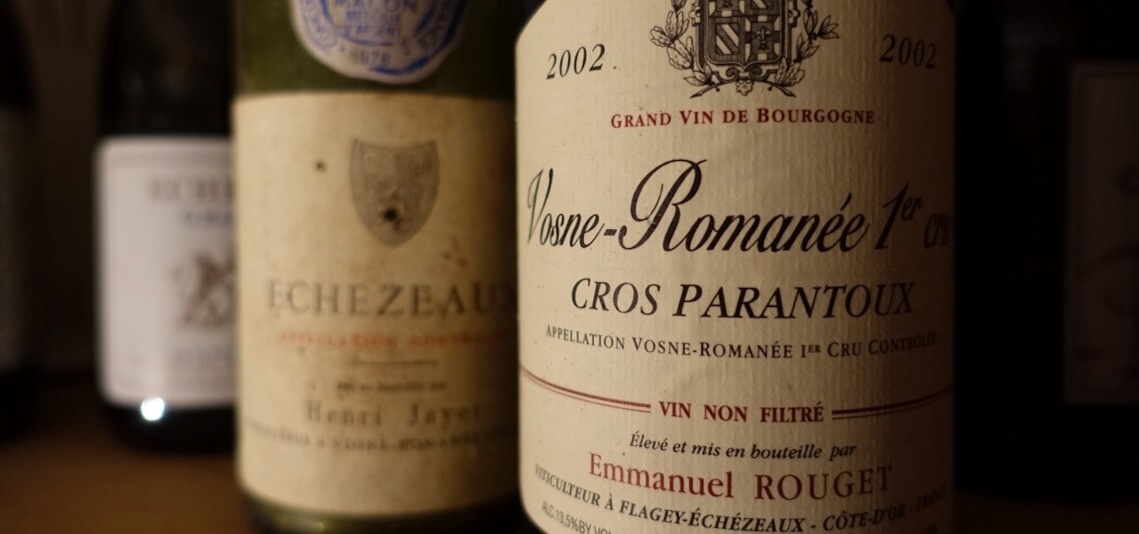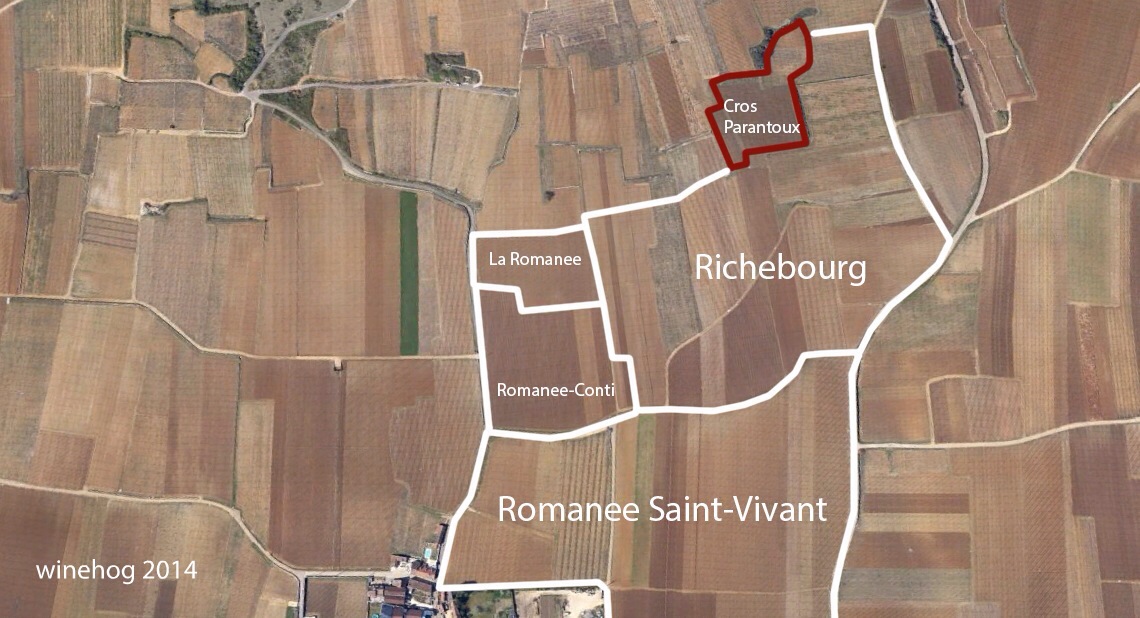Vosne-Romanee Cros Parantoux is a mythical vineyard … with a reputation created by the legendary Henri Jayer. With a location just above and next to Richebourg this 1er cru is regarded as something very special.
But the story of Cros Parantoux doesn’t start with Henri Jayer, the vineyard was known much earlier. So lets take a closer look at Cros Parantoux.
Early history of Cros Parantoux
Vosne-Romanee Cros Parantoux is located just above the northern part of Les Richebourg – the original part of Richebourg, and just south of the upper part of Les Varroilles ou Richebourg – the other climate of the current Richebourg. Cros Parantoux is east facing but sloping toward the north, just like Les Varroilles ou Richeburg. The vines are mostly planted north/south – except the southern section.
The old Cadastre map from 1827 show that Cros Parantoux had almost the same borders and area as today … there are some small changes on the border to Les Richebourg, that indicates some adjustments later on.
The map does however also indicate some rocks or vegetation in the bottom part of the terroir, just around the current border between Les Richebourg and Cros Parantoux.
Lavalle1 mention Parantoux as troisieme cru alongside Aux Petits Monts and village terroirs like Aux Commune. Clearly one of the most strange details in the Lavalle classification.
In my view the Lavalle classification clearly disfavoured the terroirs at the top of the slope, while vineyards like Clos des Vougeot located at the very bottom of the slope was highly regarded by Lavalle. This could either be explained by a preference for the richer wines produced at the bottom of the slope, or that the climate was in fact different in 1855 … thus giving lower quality at the top of the slope.
Danguy & Aubertin2 in 1892 mentioned Maignot and Robillot as the owners of Cros Parantoux and interestingly mention that Comité d’Agriculture de Beaune had classfied Cros Parantoux as deuxiéme classe.
Rodier3 in 1920 list the following owners on Aux Cros Parantoux: Camuzet, Paul Faiveley, Bredillet-Bouley and Robillot-Fondard. Furthermore the area of Cros Parantoux was mentioned as 1.15 ha by Rodier – slightly larger than the current 1.01 ha, thus confirming that the vineyard have remained relatively unchanged in size and shape since 1827.
The start of Jayer era of Cros Parantoux
Cros Parantoux never got much attention before Henri Jayer discovered the terroir in the 1950s.
According to several sources Cros Parantoux lay fallow after the phylloxera epidemic in the late 19th century, and the area was used for growing jerusalem artichokes during WW2 … and a large part of the terroir was not producing wines until the early 1950s when Henri Jayer began his work on the vineyard5.
It was hard work to replant Cros Parantoux and according to Jacky Rigeaux5 explosives were used by Jayer during the replanting and clearing the area.
According to Allen Meadows4 – Jayer acquired the first plots of Cros Parantoux in 1951 from M. Roblot and began to replant the terroir in 1953. During the next tow decades he acquired further plots, until he owned 0.7177 ha – equivalent to a bit more than 70% of the climate. According to Meadows4 the last plot was acquired in 1970 from Robert Arnoux’s sister. The Camuzet family kept their share, and own the rest of the vineyard – i.e. 0.2950 ha.
There are three cadastre plots on Cros Parantoux today, Domaine Meo-Camuzet owns the top end of the vineyard, while the Jayer family – now represented by Emmanuel Rouget – owns the two plots just above Les Richebourg – see map below.
Its important to note that Henri Jayer was talking care of the viticulture and vinification for the Meo-Camuzet family on a share-cropping basis from the early 1950s until 1987 (some sources indicate that Henri took over the Camuzet vineyards just after WW2). So while he only owned around 70% of Cros Parantoux, he was in reality managing a monopole until 1985, where Domaine Meo-Camuzet began to bottle wines under own label – still produced by Jayer though.
The Henri Jayer wines from Cros Parantoux
Henri Jayer sold much of his production of to negociants prior to 1976 – there were two very well known negociant bottlings of Henri Jayer – Caves Dessilly (Belgium), and Alexis Lichine – both mentioned Henri Jayer as the producer on the label.
Henri Jayer did however not bottle Cros Parantoux separately before the 1978 – the first vintage of Henri Jayer Cros Parantoux – and possibly the first wine to be labeled Cros Parantoux.
Prior to 1978 the wine from Cros Parantoux was presumably sold as Vosne-Romanee village. Some sources however indicate that a very large percentage of the 1976 Vosne-Romanee village from Jayer was in fact produced on Cros Parantoux.
Henri Jayer produced around 3000 – 4000 bottles of Cros Parantoux per year from 1978 to 1984. In 1985 Domaine Meo-Camuzet began to bottle a share of the production under own label. It’s unclear what happened with the Meo-Camuzet wines from 1978 to 1984 … Henri Jayer could have bottled the whole production, otherwise the Meo-Camuzet share was sold of to negociant.
From 1984 to 1988 Meo-Camuzet bottled Cros Parantoux made by Henri Jayer – presumably more or less the same wine as the Jayer bottling – but the Meo-Camuzet wines were filtered from 1984 – 1986 – while the Henri Jayer bottlings were un-filtered.
From the 1989 vintage Jean-Nicolas Meo took over from Henri Jayer as a winemaker of Domaine Meo-Camuzet – with Jayer continuing as adviser for some years more … unsure when he stopped. There seem to be a shift in style around 1996 … where the wines of Domaine Meo-Camuzet becomes darker and more extracted – so most likely Henri Jayer was out of the Meo-Camuzet equation before this.
From 1989 Emmanuel Rouget began to bottle Cros Parantoux under his own label, thus introducing a new bottling of Cros Parantoux.
In 1996 Henri Jayer retired but continued with a small production under the Henri Jayer label. Each year between 1996 and 2001 he maintained a small production of Cros Parantoux labeled as Reserve – from a 0,282 ha section of the vineyard 4. Emmanuel Rouget produced his Cros Parantoux from the remaining 0.433 ha of the terroir.
The 2001 vintage was the last vintage of Henri Jayer Cros Parantoux – the end of an era in Burgundy.
From the 2002 vintage two wines are produced on Cros Parantoux – Emmanuel Rouget (around 3000 – 3500 bottles) from a plot of 0.7177 ha and Domaine Meo-Camuzet (around 1000 bottles) from a 0.2950 ha plots.
Vosne-Romanee Cros Parantoux – the wine
Its difficult to describe a complex and generous wine like Cros Parantoux. Somehow it has become closely linked to the Jayer/Rouget style, while Meo-Camuzet for a decade or so moved towards darker and more extracted wines – after Henri Jayer stopped working for the domaine.
You need to login to read the rest of this article. If you are not a subscriber, use the subscribe function and sign-up.





 - A true vin d’émotion – a Burgundy of passion
- A true vin d’émotion – a Burgundy of passion - A truly hedonistic wine – lively and enjoyable
- A truly hedonistic wine – lively and enjoyable - A vivacious wine for pure indulgance
- A vivacious wine for pure indulgance - A potential vin d´émotion - frais et léger
- A potential vin d´émotion - frais et léger